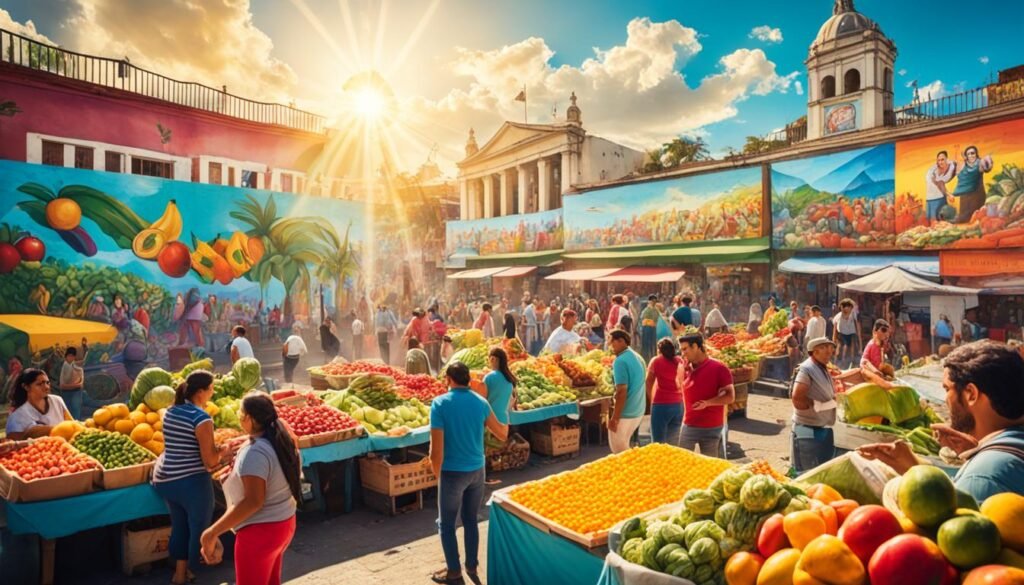Cuba, the Caribbean island nation, has long been known for its unique and enduring socialist economic system, which has had a profound impact on its capital city of Havana and the broader region. With over 60 years under a centrally planned economy, Cuba’s economic model has weathered numerous challenges, from the decline of the sugar industry to the crippling U.S. trade embargo. This article will delve into the fascinating history and evolution of Cuba’s socialist economics, exploring its origins, the obstacles it has faced, and its current state in the modern era.
Key Takeaways
- Cuba has operated under a socialist economic system since the 1959 revolution, led by Fidel Castro.
- The country’s transition to socialism has shaped its capital city of Havana and the broader Caribbean region.
- Cuba has faced significant economic challenges, including the decline of its sugar industry and tourism sector, as well as the impact of the U.S. trade embargo.
- The country’s modern economic landscape is characterized by a dual currency system, food shortages, and rising inflation.
- The future of Cuba’s socialist system remains uncertain, as the government grapples with mismanagement, crackdowns on dissent, and emigration of skilled professionals.
Cuba’s Transition to Socialism after the 1959 Revolution
In the aftermath of the 1959 revolution, Fidel Castro and the 26th of July Movement swiftly consolidated their power, overthrowing the previous Batista regime. Castro then set out to transform Cuba into a communist state, establishing a centrally planned socialist economy and aligning the country closely with the Soviet Union and other Eastern Bloc nations.
Fidel Castro’s Rise to Power and the Overthrow of Batista
Fidel Castro, a charismatic revolutionary, led the successful overthrow of the corrupt Batista government, which had long ruled Cuba with an iron fist. Castro’s guerrilla forces, the 26th of July Movement, emerged victorious after a protracted struggle, ushering in a new era of communist revolution in the Caribbean island nation.
Establishment of a Centrally Planned Economy and Alignment with the Soviet Bloc
Following their triumph, Castro and his allies moved quickly to reshape Cuba’s economic landscape. They nationalized private businesses, collectivized agricultural production, and established a centrally planned economy modeled after the Soviet Union’s system. Cuba’s alignment with the communist bloc, forged through trade agreements and political alliances, would have far-reaching consequences for the country’s future development.
Economic Challenges and Stagnation
Over the decades, Cuba’s socialist economy has faced significant hurdles, including the decline of the once-thriving sugar industry and tourism sector. The US trade embargo, implemented after the revolution, as well as the loss of crucial Soviet support following the collapse of the Soviet Union, have further exacerbated Cuba’s economic struggles, leading to stagnation and declining living standards for many Cubans.
Decline of the Sugar Industry and Tourism Sector
The sugar industry, which had long been the backbone of Cuba’s economy, experienced a steady decline in the years following the 1959 revolution. The government’s efforts to diversify the economy and reduce reliance on sugar exports were unable to fully offset the impact of this downturn. Similarly, the tourism sector, which had been a significant source of revenue, also faced challenges as political tensions and economic constraints limited the country’s appeal as a travel destination.
Impact of the U.S. Trade Embargo and Loss of Soviet Support
The US trade embargo, imposed in the aftermath of the revolution, severely restricted Cuba’s ability to engage in international trade and access essential resources. This, combined with the loss of vital economic support from the Soviet Union following its collapse, dealt a major blow to the Cuban economy. The country’s dependence on the Soviet bloc for trade, investment, and subsidies left it ill-prepared to withstand these shocks, leading to widespread shortages, declining productivity, and a significant deterioration in living standards for many Cubans.

Cuba’s Modern Economic Landscape
In recent years, Cuba has undertaken limited economic reforms, including the introduction of a dual currency system and the legalization of small private businesses. These measures, however, have been hampered by mismanagement, currency devaluation, food shortages, and rising inflation, leaving the country’s overall economic landscape in a precarious state.
Dual Currency System and Devaluation
Cuba’s dual currency system, which features both the national peso and the convertible peso (CUC), has been a source of confusion and economic distortion. The CUC, pegged to the US dollar, is used for certain transactions, while the national peso is used for everyday purchases. This system has led to currency devaluation, making it increasingly difficult for Cubans to afford basic necessities.
Food Shortages and Rising Inflation
Persistent food shortages and rising inflation have further exacerbated the economic challenges facing Cuba. The country’s dependence on imports and the impact of the ongoing US trade embargo have contributed to these issues, forcing Cubans to navigate a complex web of supply chain disruptions and price fluctuations.
Despite the implementation of economic reforms, Cuba’s modern economic landscape remains fragile, with the dual currency system, food shortages, and rising inflation posing significant obstacles to the country’s long-term stability and development.
Cuba: Caribbean Socialist Economics Havana Cuba
As the capital and largest city of Cuba, Havana has been at the center of the country’s socialist economic experiment. The city’s once-thriving tourism industry, reliance on exports like sugar, and close ties to the United States have all been significantly impacted by Cuba’s transition to a centrally planned economy and the subsequent challenges it has faced.
Prior to the 1959 revolution, Havana was a popular destination for American tourists, who flocked to the city’s vibrant nightlife, casinos, and beaches. However, the establishment of a socialist government under Fidel Castro led to the nationalization of the tourism industry and the loss of U.S. investment. This, coupled with the U.S. trade embargo, severely crippled Havana’s economy, which had long been dependent on the Caribbean tourism and sugar exports.
Today, Havana’s economy remains in a state of flux, as the government attempts to balance its socialist ideals with the need for foreign investment and economic diversification. The city’s aging infrastructure, limited access to modern technology, and shortages of consumer goods have all contributed to a challenging economic environment. Nevertheless, Havana continues to be a hub of cultural and artistic activity, drawing visitors from around the world who are drawn to its unique blend of colonial architecture, vintage automobiles, and Cuban charm.

As Cuba navigates its socialist economic model, the future of Havana and its role within the larger Caribbean economy remains uncertain. However, the city’s resilience and adaptability in the face of significant challenges suggest that it will continue to play a pivotal role in shaping the country’s economic and cultural landscape for years to come.
Government Under Miguel Díaz-Canel
Since taking office in 2018, President Miguel Díaz-Canel has maintained Cuba’s socialist economic model. However, his administration has been plagued by widespread mismanagement and dysfunction. The Cuban government’s inability to address the country’s pressing economic challenges has fueled growing discontent among the people.
Mismanagement and Dysfunction
Under Díaz-Canel’s leadership, the Cuban government has struggled to manage the economy effectively. Food shortages, rising inflation, and a stagnant standard of living have become the norm. Díaz-Canel’s policies have failed to stimulate economic growth or improve the living conditions of the Cuban people, leading to widespread frustration and disillusionment.
Crackdown on Dissent and Protests
In response to the growing public unrest, the Díaz-Canel government has resorted to a heavy-handed crackdown on political dissent and protests. Activists, journalists, and civil society leaders have faced increased harassment, arbitrary arrests, and political repression. This heavy-handed approach has only served to further alienate the Cuban people and exacerbate the country’s political and social tensions.
The challenges faced by the Díaz-Canel government highlight the larger issues plaguing Cuba’s socialist economic model. As the country grapples with mounting economic and social pressures, the future of Cuba’s political and economic systems remains uncertain.
Emigration and Brain Drain
The economic challenges and political repression in Cuba have led to a significant wave of emigration, with hundreds of thousands of Cubans leaving the island in recent years. This Cuban emigration has further exacerbated the country’s economic woes, as many of the most educated and skilled citizens seek better opportunities abroad, contributing to a brain drain.
The economic crisis and lack of freedoms in Cuba have pushed many of the nation’s professionals, such as doctors, engineers, and academics, to leave the country in search of a better life. This brain drain has taken a toll on Cuba’s ability to develop its economy and infrastructure, as the loss of highly skilled workers has left critical sectors understaffed and underperforming.

The Cuban government has attempted to stem the tide of emigration, but its efforts have been largely ineffective. Strict travel restrictions and crackdowns on dissent have done little to address the underlying causes of the economic crisis and political repression that drive Cubans to leave the country. As a result, the brain drain continues to be a significant challenge for Cuba, further undermining its ability to achieve economic and social progress.
The Rise of Private Businesses
Despite Cuba’s socialist economic system, the country has witnessed a remarkable proliferation of private businesses in recent years. This explosion of entrepreneurship and small enterprises has posed significant challenges to the traditional socialist model, underscoring the growing demand for greater economic freedom and flexibility.
Explosion of Entrepreneurship and Small Enterprises
The Cuban government has gradually introduced a series of economic reforms, allowing for the expansion of private businesses. This has led to the emergence of modern grocery stores, online supermarkets, and furniture showrooms, among other enterprises. These private businesses have become increasingly visible in the country’s economic landscape, catering to the evolving needs and preferences of the Cuban population.
Challenges to the Socialist Economic Model
The rise of private businesses in Cuba has challenged the core principles of the socialist economic model. These small enterprises have introduced market-driven practices, such as pricing based on supply and demand, rather than centralized government control. This shift has sparked debates within the country about the balance between socialist ideals and the need for economic reforms to meet the changing demands of the population.
As Cuba continues to navigate its economic landscape, the growth of private businesses and entrepreneurship will likely play a significant role in shaping the future of the country’s socialist system. The government’s ability to strike a balance between its ideological commitments and the practical realities of the modern economy will be a crucial factor in determining the success of these reforms.
Cuba’s Relationships with Latin American Nations
Cuba’s socialist economic model and political ideology have significantly influenced its relationships with other Latin American countries. As a leading proponent of left-leaning governance in the region, Cuba has forged strong ties with nations that share similar political leanings, while navigating more complex relations with those with more conservative administrations.
Throughout the Caribbean and the Americas, Cuba’s unique position has shaped its economic and diplomatic connections. The island’s commitment to socialist principles has led to close cooperation with countries like Venezuela, Bolivia, and Nicaragua, where left-wing governments have embraced Cuba’s economic and political model. These regional alliances have bolstered Cuba’s diplomatic standing and provided access to vital trade and financial support.

At the same time, Cuba’s socialist system has created tensions with more conservative governments in the region, such as those in Colombia, Brazil, and Argentina. These nations have often viewed Cuba’s political ideology as a threat to their own economic and social order, leading to strained diplomatic relations and, in some cases, economic sanctions and trade barriers.
Despite these challenges, Cuba has remained a significant player in Latin American regional affairs, leveraging its political influence and economic ties to shape the broader geopolitical landscape. As the island nation continues to navigate the complexities of its socialist economic model, its relationships with its Latin American neighbors will likely remain a key factor in its future development.
The Future of Cuba’s Socialist System
As Cuba grapples with ongoing economic crises, emigration, and political repression, the future of its socialist system remains uncertain. While the government has implemented some limited economic reforms in recent years, the regime’s resistance to significant political liberalization suggests that major changes may be slow in coming, despite the growing discontent among the Cuban people.
The Cuban economy has been struggling for decades, with shortages of basic goods, high inflation, and a dual currency system that has contributed to economic stagnation. The government’s efforts to attract foreign investment and expand the private sector have had limited success, as they have been constrained by the country’s socialist model and the continued domination of state-owned enterprises.
Similarly, the government’s crackdown on dissent and protests has done little to address the underlying political and social issues that have fueled the country’s unrest. Cuba’s leaders have resisted calls for greater political freedoms and democratic reforms, arguing that such changes would undermine the country’s socialist system and its independence from foreign influence.
Nonetheless, the pressures for change in Cuba are mounting, and it remains to be seen whether the government will be able to maintain its grip on power in the face of growing economic and political challenges. As the country navigates an uncertain future, the outcome of its socialist experiment will have significant implications for the Caribbean region and beyond.
Conclusion
Cuba’s unique socialist economic experiment has left an indelible mark on the country, its vibrant capital city of Havana, and its relationships within the broader Caribbean and Latin American regions. While the system has faced significant challenges over the decades, including economic stagnation, emigration, and political repression, the future of Cuba’s socialist model remains uncertain as the country continues to navigate a complex and evolving landscape.
Despite the obstacles, Cuba’s commitment to its socialist principles has endured, and the country’s influence continues to be felt throughout the region. As the world watches closely, it remains to be seen whether Cuba’s economic and political system will adapt and evolve, or if the country will face further upheaval and change in the years to come.
Ultimately, Cuba’s story serves as a testament to the complexities and nuances of socialist economics, and the profound impact it can have on a nation and its people. As the country’s leadership and citizens grapple with the realities of the present and the uncertainties of the future, the world will undoubtedly continue to closely monitor the unfolding of this unique and captivating Caribbean story.
Source Links
- In a Communist Stronghold, Capitalists Become an Economic Lifeline – https://www.nytimes.com/2024/04/29/world/americas/cuba-economy-communism-capitalism.html
- Cuba – Caribbean, Revolution, Communism – https://www.britannica.com/place/Cuba/The-Republic-of-Cuba
- Why the Situation in Cuba Is Deteriorating – https://www.cfr.org/in-brief/why-situation-cuba-deteriorating


